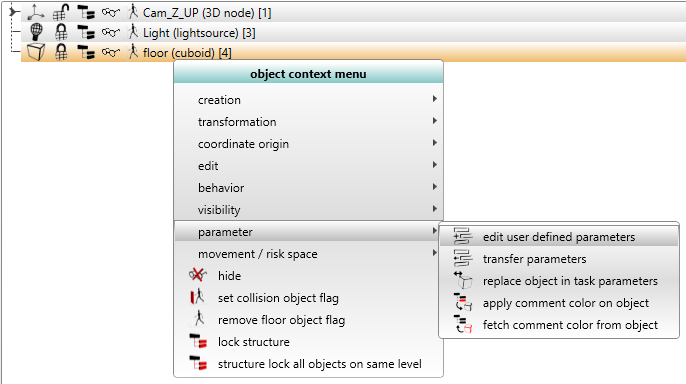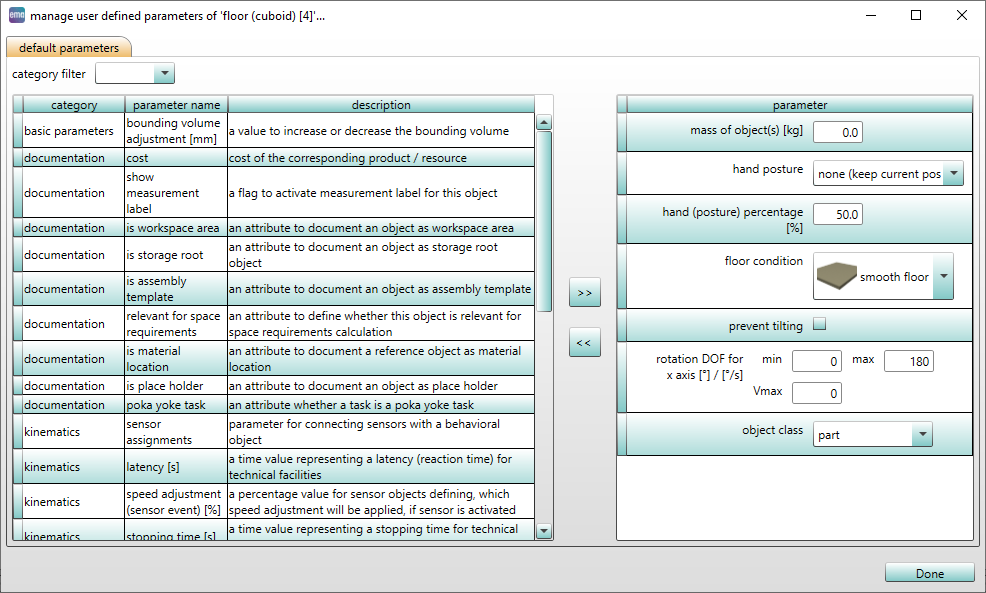User defined object parameters can be defined via the selected object’s context menu, which lies within the Tab "Objects". When the menu item Parameter -> Edit user defined parameters is selected (see figure Edit user defined parameters), a dialog box Manage user defined parameters of [object] is opened (see figure Manage user defined parameters).

Figure 186: Edit user defined parameters

Figure 187: Manage user defined parameters
This dialog box have two distinct regions. On the dialog box‘s left side, the available object characteristics which are currently inactive along with its category, parameter name and description are provided in the form of a table. On the right side, the selected and activated object parameters are enlisted as “parameter“. The values can be preassigned to the activated object properties in the corresponding fields (except for object selection buttons). Multi-select feature is available for the object parameters on the both side of the dialog box and the selected object parameters can be switched between the two sides using ![]() and
and ![]() .
.
The parameters are grouped under various categories namely; Basic parameters, Documentation, Kinematics, Line balancing and variants, Object handling, and Welding. The Category filter on the top-left corner of the dialog box enable the user to show or hide the required category(s) of parameters.
The current user defined parameters are as shown in the table:
Category |
Parameter |
Type |
Meaning |
|---|---|---|---|
Basic parameters |
Bounding volume adjustment [mm] |
Floating-point number |
Value to increase or decrease the bounding volume. |
Basic parameters |
Floor condition |
Selection |
A parameter that describes the conditions of the floor when walking over the object; used for evaluation purposes. |
Documentation |
Cost |
Floating-point number |
Parameter Costs are used to calculate the costs of the respective product or the respective resource. The individual costs and the total cost are displayed in the Objects report (see chapter User interface / Tab "Results" / Objects report). The currency used for this can be set as described in chapter User interface / Menu bar / Options / Settings / User interface. |
Documentation |
Show measurement label |
Checkbox |
An attribute to enable or disable the display of object dimensions in the 3D view. Prerequisite for this display is that the switch object measurement labels mode button is set to visible in the 3D settings (see chapter User interface / 3D settings / Documentation). The text size can be adjusted using the parameter text size of measurement labels [mm] defined in 3D viewer in options (see chapter User interface / Menu bar/ Options/ Settings/ 3D viewer). |
Documentation |
Is workspace area |
Checkbox |
A parameter to document an object as workspace area. |
Documentation |
Is storage root |
Checkbox |
A parameter to document an object as storage root object. |
Documentation |
Is assembly template |
Checkbox |
A parameter to document an object as assembly template. |
Documentation |
Relevant for space requirements |
Checkbox |
A parameter to define whether this object is relevant for space requirements calculation. |
Documentation |
Is material location |
Checkbox |
A parameter to document an object as material location. |
Documentation |
Is place holder |
Checkbox |
A parameter to document an object as place holder. |
Documentation |
Poka yoke task |
Checkbox |
A parameter to define a task as a poka yoke task. |
Kinematics |
Sensor assignments |
Object |
Parameter for connecting sensors with a behavioral object. |
Kinematics |
Latency [s] |
Floating-point number |
A time value representing a latency (reaction time). |
Kinematics |
Speed adjustment (sensor event) [%] |
Floating-point number |
A percentage value for sensor objects defining the speed adjustment which will be applied, if the sensor is activated |
Kinematics |
Stopping time [s] |
Floating-point number |
A time value representing a stopping time. |
Kinematics |
Rotation DOF for |
Floating-point number |
A rotation DOF (degree of freedom) which can be used with inverse kinematics functionalities. |
Kinematics |
Rotation DOF for |
Floating-point number |
A rotation DOF (degree of freedom) which can be used with inverse kinematics functionalities. |
Kinematics |
Rotation DOF for |
Floating-point number |
A rotation DOF (degree of freedom) which can be used with inverse kinematics functionalities. |
Kinematics |
Translation DOF for |
Floating-point number |
A translation DOF (degree of freedom) which can be used with inverse kinematics functionalities. |
Kinematics |
Translation DOF for |
Floating-point number |
A translation DOF (degree of freedom) which can be used with inverse kinematics functionalities. |
Kinematics |
Translation DOF for |
Floating-point number |
A translation DOF (degree of freedom) which can be used with inverse kinematics functionalities. |
Kinematics |
Use old motion generator |
Checkbox |
[only digital models] A parameter which activates the old motion generator from version 2.0.3.1. |
Line balancing & variants |
Process location |
Object |
Link to the location of this process. |
Object handling |
Prevent tilting |
Checkbox |
Attribute to prevent object tilting during manipulation processes. |
Object handling |
Helper object(s) |
Object |
Parameter for adding additional helper object(s) (e.g. tool center point, grab points). |
Object handling |
Object characteristics |
Selection |
A parameter to define the characteristics of an object. |
Object handling |
Object class |
Selection |
Object class specification for reporting purposes. |
Object handling |
Operating path |
Path |
Definition of an operating path (mainly used for actuator objects). |
Object handling |
Object coupling type |
Selection |
[NIOSH] An attribute which describes the quality / way this object may be picked and handled. |
Object handling |
Instability |
Selection |
Attribute defining an object as unstable. |
Object handling |
Bulkiness |
Checkbox |
Attribute defining an object as bulky. |
Object handling |
Mass of object(s) [kg] |
Floating-point number |
A value representing the mass of an object in [kg]. |
Object handling |
Hand posture |
Selection |
A hand posture which should be used to handle an object |
Object handling |
Hand (posture) percentage [%] |
Floating-point number |
Percentage value to fine tune the hand posture between open hand (0%) and the defined hand posture (100%). |
Welding |
Difficult welding spot |
Checkbox |
Attribute for defining this weld spot as ‘difficult’ (influences weld time determination) |
Welding |
Add. weld process time [s] |
Floating-point number |
Additional process time for this weld point (used for weld time determination) |
The dialog box can be closed by clicking the button Done. Corresponding to an object in the Objects tab, the active user defined parameters are highlighted.